Expedition Log: Palau – Day 4
 Today, as we prepare to leave the Rock Islands and head to Negerumekao – the Global Reef Expedition’s next research site in Palau – we take a minute to reflect on the stunning natural wonders of the site. The unique limestone islands, large schools of fish, healthy and diverse reefs, it’s truly a special place – and we’re not the only ones to think so. One of the reasons we chose to map and survey coral reefs in the Rock Islands is because it is a UNESCO World Heritage site. Hear from Fanny Douvere, Head of UNESCO’s World Heritage Marine Programme, about what this means, and why it’s such a special designation.
Today, as we prepare to leave the Rock Islands and head to Negerumekao – the Global Reef Expedition’s next research site in Palau – we take a minute to reflect on the stunning natural wonders of the site. The unique limestone islands, large schools of fish, healthy and diverse reefs, it’s truly a special place – and we’re not the only ones to think so. One of the reasons we chose to map and survey coral reefs in the Rock Islands is because it is a UNESCO World Heritage site. Hear from Fanny Douvere, Head of UNESCO’s World Heritage Marine Programme, about what this means, and why it’s such a special designation.
In 2012, Palau’s Rock Islands Southern Lagoon was granted the prestigious status UNESCO World Heritage. A marine place considered of such globally significant importance that its disappearance would be an irreversible loss to humanity. It joined a well-established collection of iconic World Heritage sites such as the Great Barrier Reef in Australia, the Taj Mahal in India and the Galapagos Islands in Ecuador. But what does it really mean to be included on UNESCO’s World Heritage List?
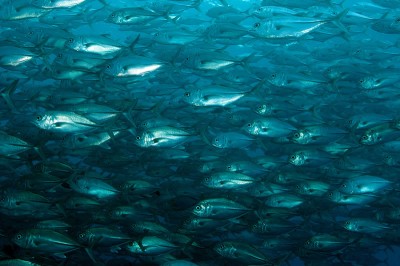
Large schools of fish like these Bigeye Jacks (Caranx sexfasciatus) greeted us at the start of our dives.
The 1972 UNESCO World Heritage Convention is founded on the premise that certain places on earth are of Outstanding Universal Value and as such should form part of the common heritage of humankind. Sites are selected through a rigorous, multi-annual review of their unique geological and ecological processes, their exceptional biodiversity and other key criteria. The Palau’s Rock Islands is listed for its unique mushroom-like limestone islands, uniquely diverse turquoise lagoons surrounded by precious coral reefs while simultaneously also representing an exceptional testimony of the organization of small island communities over three millennia.
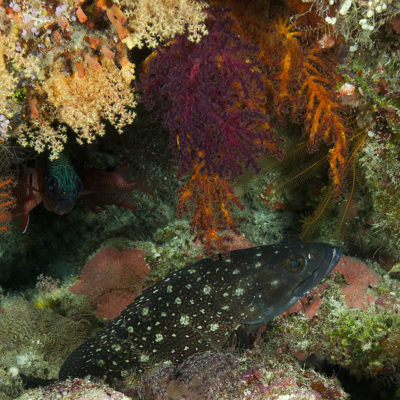
This White Spotted Grouper (Epinephelus caeruleopunctatus) hiding beneath an overhang surrounded by soft corals is just a sample of the healthy and diverse coral reefs of Rock Islands Southern Lagoon.
But this recognition for its exceptional value is just a start. As a condition for receiving the prestigious World Heritage designation, nations commit to stewarding their sites into the future, ensuring that these exceptional places endure through government transitions. All sites, and thus also Palau’s Rock Islands, are subject to a continuous monitoring and evaluation, undertaken by UNESCO’s World Heritage Centre and its official advisory bodies including the International Union for the Conservation of Nature (IUCN). The findings of the monitoring are featured in periodic scientific reviews and state of conservation reports. Ultimately, they form the basis for the annual World Heritage Committee who decides whether a site is well protected, or if it is not, to place it on the List of World Heritage in Danger. The Danger List functions as an “alarm bell” to the international community, indicating that a truly exceptional place is on the brink of extinction. The World Heritage Committee also has the power to delist a site if its universal value would be irrevocably lost and has done so twice since its inception.
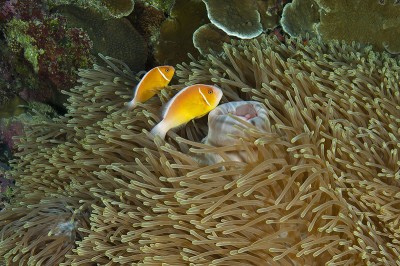
Pair of Pink Anemonefish (Amphiprion perideraion) in a large Leathery Sea Anemone (Heteractis crispa) make the Southern Lagoon their home.
World Heritage marine sites are typically multiple use areas where a multitude of stakeholders are implementing a variety of conservation and income-generating activities. So is Palau’s Rock Islands Southern Lagoon. In 2012, the World Heritage Committee requested Palau’s government address the present and potential future impacts of tourism and ensure careful mitigation planning in vulnerable areas. It also emphasized the need to strengthen the scientific understanding of the site with the help of national and international organizations, and use this information to provide an adaptive approach to its management. A comprehensive overview of all requests is available at: http://whc.unesco.org/en/list/1386/documents/
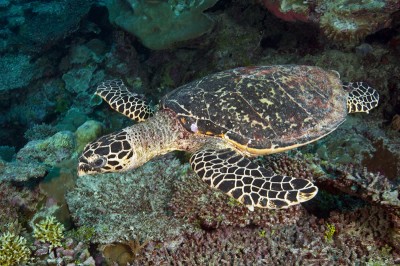
Hawksbill Sea Turtle (Eretmochelys imbricata), another inhabitant of Rock Islands Southern Lagoon.
This periodic review process is firmly embedded in the workings of the World Heritage Convention and prevents these exceptional places to be mere “paper parks”. It is the central mechanism through which nations are held accountable for conserving the exceptional characteristics that earned the site a place on the World Heritage List. The Convention has matured over more than 40 years and is the only such mechanism in the world.
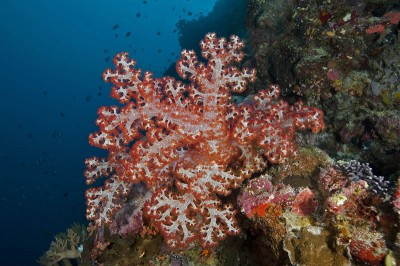
Bright red Dendronephthya soft coral looks purple underwater till it is hit with the light of a camera strobe.
The UNESCO World Heritage Marine Programme is mandated to ensure the effective conservation of 47 existing and any potential marine areas of Outstanding Universal Value to make sure they will be maintained and thrive for generations to come. More information at: http://whc.unesco.org/en/marine-programme/
Photos by Ken Marks.